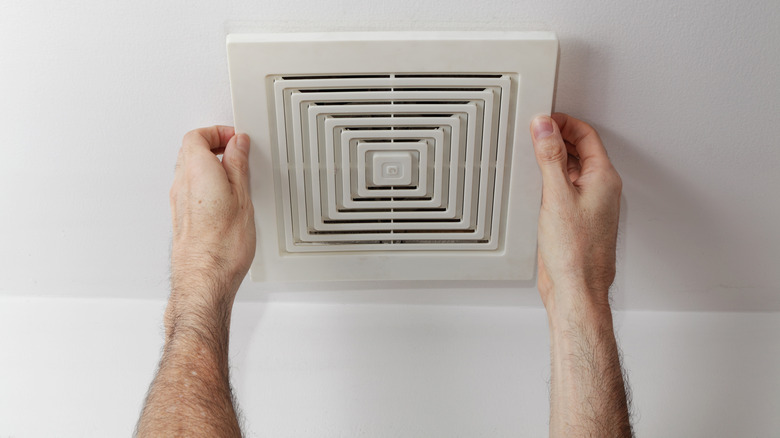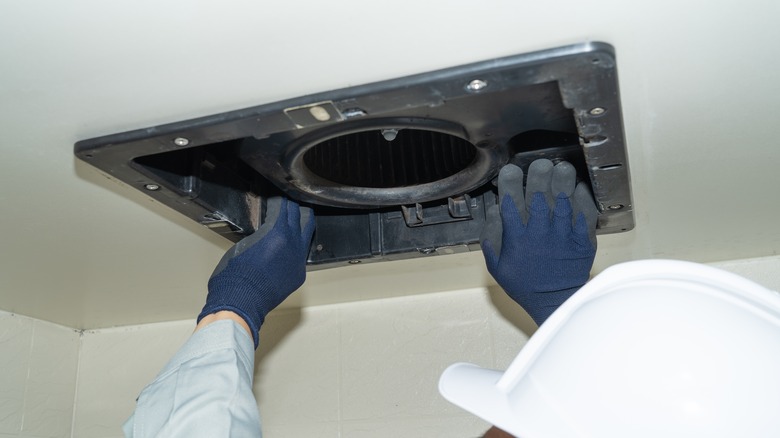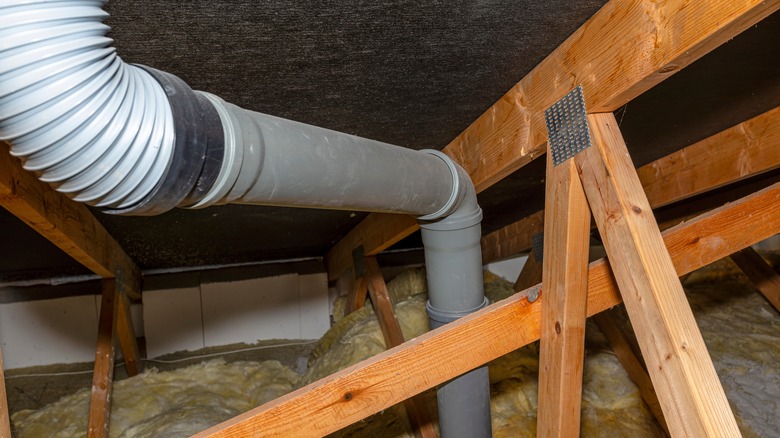Should You DIY A Bathroom Exhaust Fan Replacement Or Call In The Pros? Our Electrician Weighs In
Bathroom fans are important for reducing the humidity and preventing mold growth in your bathroom — not to mention venting unpleasant odors. Fans are the best way to vent a bathroom and keep it mold-free, especially if the room has no windows, and venting fans may even be required in building codes for certain areas. If you have a bathroom fan, you probably understand how useful it can be, but like all home features, bathroom fans can slow down and eventually break over time. There may come a day when it's time to replace your bathroom fan, but is it safe or smart to do it on your own?
In an exclusive interview with House Digest, we spoke to Chris Lozano, an electrician and virtual electrical expert at Frontdoor. When it comes to performing your own bathroom fan installation or replacement, Lozano explains, "It depends on the comfort level of the homeowner with installation, making sure they take the necessary precautions (for example, making sure electricity is off) and [they have] the right tools." Here are Lozano's tips and precautions for anyone determined to DIY their fan installation and times when he believes it's better to call in the pros.
DIYing requires special precautions
Before touching any electrical components of your home, you should always shut off the electrical breaker. "Make sure the electricity is off and cannot be accidentally turned on while you are working on the installation," says electrician Chris Lozano, who recommends wearing gloves for another important reason, too: "Exhaust fans themselves can be sharp and easily cut your hands and arms." Additionally, he advises DIY-ers to "Be prepared for insulation which may fall when you pull the fan down from the ceiling," so wearing a mask could be a smart move, too.
Some people may expect putting in a new bathroom exhaust fan to be a simple, in-and-out ordeal, but in his exclusive interview with House Digest, Lozano explained that it's not always so simple. "It is important to get accurate measurements of the hole in the ceiling and the actual vent cover of your new bathroom fan replacement to make sure they will match," says Lozano, "If the new vent is larger, you will need to make sure there is no existing framing that will stop you from being able to open the hole more. And if the new vent is smaller, you will have to patch the sheetrock so that no attic air gets into the room." To cut a larger hole for the new fan, Lozano explains that you'll need a special drywall saw, but some fan kits include a template that can make tracing and cutting easier.
Finish in the attic
Installing a new bathroom exhaust fan might seem easy, but bathroom vents go much deeper than what you can see on the ceiling. Fans ducts need to be properly placed, as pumping hot, humid air into your attic could cause mold. "Ensure that the fan is vented outside through the roof, siding, or soffit," Chris Lozano explained when he spoke exclusively to House Digest, "If it is not, this is an important step of the installation you -– or a professional -– will have to do as well."
While Lozano wants homeowners to feel empowered, he advocates that some situations may necessitate calling a professional, such as an awkward ceiling angle or complex structures in an older home. "For these cases, I suggest planning on hiring an electrician to install the fan and the vent," says Lozano, "If the electrician does not want to do the venting, also contract a carpenter who can take care of the roof, siding, or soffit penetration for the vent. A carpenter could also reframe and patch whatever damage might occur to the ceiling." In many ways, it pays off to have a professional perform the fan installation, even if you have to hire more than one — but if you're still unsure, it never hurts to call for a quick consultation. "To gauge and discuss if it should be a DIY or professional job, homeowners could do a video chat with an electrical expert at Frontdoor first," Lozano concludes.


